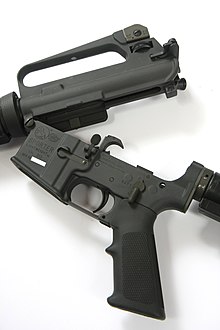Not sure what you're talking about here. Of all the M-16 variants, only the A1 and A2 versions address reliability concerns
Not Quite.
Pre A1 a number of changes were made that were standardized in the A1 spec. These were to address reliability issues in Vietnam.
And The key reason of those early issues were related more to changes in specification of Ammunition. The Original Specifications were for IMR powder the Ordnance Corps instead chose Ball powder. Like Fueling a Gasoline Engine with Jet fuel It's going to cause issues. Ball powder burns faster which created a increased mechanical rate of fire by over 200 rounds per minute. A weapon designed to cycle at 800 repetitions per minute was suddenly working at over 1000.
The ball powder also introduced fouling into the chamber from changes in burn and was not as easily cleaned with finally high humidity causing corrosion on the gas tube and Receivers from inferior materials.
The A1 addressed the reliability issues by Chrome plating the chamber and barrel increasing barrel life easing cleaning and Changing of the Gas tube to Stainless steel. Changing buffer springs to reduce wear by rate of fire. The receivers were changed from lower grade Aluminum to Aircraft grate 7075, adoption of captive pins and installation of a rub around the magazine release to prevent accidental unloading.
Between A1 and A2 the 30 round magazine was introduced.
CAR 15 with shortened barrel telescopic stock and round handguard introduced. testing showed issues with the 10.5 inch barrels so a 4 inch muzzle device was added creating a 14.5 inch length
This was followed by the Limited introduction of the M16A1 Carbine at a 16 inch barrel.
The A2 changed the rifling for NATO spec ammo, new sights and gas block ( front sight post), Stock with cleaning kit carrier, new handguards and introduced the 3 round burst and standardized bolt assist on a redesigned upper and lower. A2 also introduced the A2 Barrel profile tapers where the barrel narrows for mounting of a M203 then widens again and narrows for the gas block then widens
A3 was an A2 with a 4 place selector safe, semi 3 round and full auto.
The M4 Carbine was developed after the M16A2 as a Carbine derivative, using lessons learned from the CAR15 it had a 14.5 inch barrel. as it was developed US SOCOM came in and asked for a Full Auto option and M1913 Rails These were new an supposed to be just for Socom use. M4 would suffer from the A2 barrel profile A2 buffer and shortened gas tube. M4 introduced new feed ramps, an improved telescopic stock.
A4 swapped the upper receiver for a M4 style with M1913 rails and changed the gas block to raise the front sight to match.
The M4A1 was developed due to issues of the barrel and high heat high stress from pressure being placed on the barrels the A2 barrel profile caused issues because if narrowed after the Trunnion IE the point of highest Heat and pressure then widened. M4A1 addressed this by changing buffers, moving to a heavier barrel and beginning to free float the handguard.
And there are still improvements being offered.
All of which shows us that these are mechanical systems that are adapted and changed to meet their current users wants and needs.
Reliability of a Machine ( make no mistake Rifles are Mechanical devices.) depends primarily on consistent specifications and Quality. AK's have Jammed. The INSAS is often disdained yet it is an AK design why does it fail? because the Indian producer was not able to maintain a high consistency in Quality control and Quality control is meeting Specifications.
You cannot expect a machine assembled with poor quality components to perform to high quality specifications. If you run ammunition that doesn't meet specifications though a AR it will fail. if you allow foreign Debris in the operation of a AK it will jam, If you construct a rifle out of poor quality materials it will fall apart.

